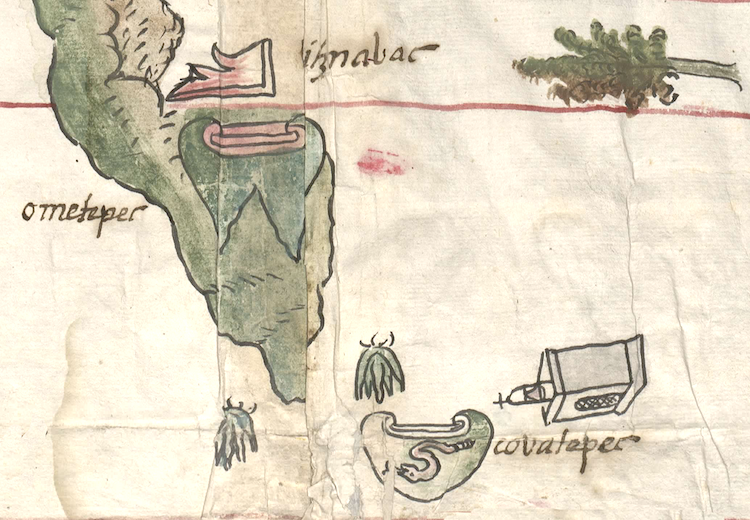Coatepec (CmpRG)
This compound glyph stands for the place name Coatepec ("Serpent Hill"). It is an Indigenous community that appears on the 1580 Relación Geográfica de Cempoala (originally, Cempohuallan). The glyph consists of a hill or mountain (tepetl) with a coiled snake (coatl) superimposed on it. The locative -c is not visualized unless the hill serves that purpose. The elements of the glyph are outlined in black. The tepetl is partially shaded in green, while the body and head of the coatl are shaded in tan. The tepetl is rather short and rounded, with black-outlining but otherwise uncolored stripes, curled at each end, at its base. The coatl is shown in profile, facing toward the viewer's right. It is a rattlesnake complete with a segmented tail, and despite some damage to this part of the pictorial, it can be seen with a forked tongue emerging from its mouth. The glyph is shown next to a drawing of a church which seems to work as a semantic indicator that Coatepec is an inhabited place rather than simply a hill in the landscape (see the historical contextualizing image).
Robert Haskett
Coatepec was one of the sujetos of Tlaquilpan, one of Cempohuallan's four caberceras [head towns]. The placement of the place glyph next to a church agrees with the Spanish text of the Relación itself, which emphasizes that all of Cempoala’s dependent communities have churches. Aside from the semantic element of the church mentioned, above, this glyph shows much less obvious Spanish influence than some of the others found on the map. It appears along one edge of the manuscript below and to the right of two tepetl, Ometepec and Huitznahuac (see the historical contextualizing image and entries for these two landscape features elsewhere in the Visual Lexicon). There are also two maguey plants in the vicinity, suggesting an area that, according to Peter Gerhard, is “a rolling, maguey-covered country of volcanic cones rising slightly above the plain” that eventually featured a number of estates dedicated to the production of pulque (67-68). For a study of the RG, see Mundy, Barbara E., “Mapping Babel: A Sixteenth-Century Indigenous Map from Mexico,” The Appendix, 1:4 (October 2013), Mundy (1996), and Ballesteros García (2005), 62. For further information about the Cempoala region, see Gerhard, Historical Geography of New Spain (1972).
Robert Haskett
couatepec
Coatepec
Robert Haskett
1580
Robert Haskett
place name, snake, serpent, culebra, serpiente, hill, mountain, cerro, cohuatl, nombres de lugares, crótalos
Coatl. This small, carved rattlesnake that was found among offerings dedicated to Tlaloc at the Templo Mayor. The curvature of its body suggests movement. Photograph by Stephanie Wood, Museo del Templo Mayor, 15 February 2023; this commentary by Robert Haskett and Stephanie Wood.

coa(tl), snake, serpent, https://nahuatl.wired-humanities.org/content/coatl
tepe(tl), hill, mountain, precipice, https://nahuatl.wired-humanities.org/content/tepetl
El Cerro de la Culebra, o el Pueblo de la Culebra
Robert Haskett
Relación de Zempoala - University of Texas Libraries Collections. 1580-11-01. https://collections.lib.utexas.edu/catalog/utblac:f87917e2-e3c9-4eb2-a83...
Materials that are in the public domain (such as most of the maps in the PCL Map Collection), are not copyrighted and no permission is needed to copy them. You may download them and use them as you wish. The image appears here courtesy of the University of Texas Libraries, The University of Texas at Austin.







